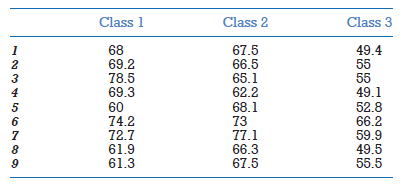We can calculate the F statistic as follows BSS = 5 * (7.6 - 6.7)2 + 5 * (6.0 - 6.7)2 + 5 * (6.64 - 6.7)2 = 6.5 WSS = (5 - 1)*1.12 + (5 - 1)*0.82 + (5 - 1)*0.62 = 8.8 F = (BSS / (k-1)) / (WSS / (n-k)) = (6.5 / 2) / (8.8 / 12) = 4.43 Similarly, the KW statistic is given by summing the ranks of the different groups, so that we get H = (12/(n(n+1)) sum{i=1->k} Ri 2 / ni) - 3(n+1) = (12/(15(15+1)) sum{i=1->k} Ri 2 / ni) - 3(15+1) = 0.05 (572/5 + 232/5 + 402/5) - 48 = 5.78 Thus, comparing F with F.05,2,12 = 3.89, the critical value leads us to reject the null hypothesis. Comparing H with the chi-squared2 = 5.991, so that we fail to reject the null hypothesis. Sometimes the lack of power associated with a nonparametric test prevents us from rejecting the null hypothesis.

a. Consider the post hoc contrasts between the different groups. Do any groups stand out?
b. Using the results from part (a), test the hypothesis that mean test score of one group differs from those of the other two.
a. b. Using the results from part (a), test the hypothesis that mean test score of one group differs from those of the other two.
b. The test for homogeneity suggests that we can assume equal variances. Then, with coefficients .5, .5, and -1, the a priori contrasts suggest a difference of 13.0 between the means, at a significance level of less than .001. Thus, we can reject the null hypothesis and conclude confidently that the results of Class 3 were statistically different from those of Classes 1 and 2.
You might also like to view...
Excess water evaporated into the atmosphere over the oceans is carried by wind over land areas, where it condenses into clouds and falls as precipitation
Indicate whether the statement is true or false.
Some pollutants are able to persist in the environment for thousands of years
Indicate whether the statement is true or false
A thermometer with a small constriction just above the bulb is a(n) ____ thermometer
A) maximum B) minimum C) electrical D) bimetallic
Even in a low emissions scenario on climate change, water stress will increase by:
A) 38% B) 24% C) 56% D) 17% E) 5%